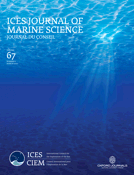-
PDF
- Split View
-
Views
-
Cite
Cite
Michael O. Hammill, Garry B. Stenson, Comment on “Towards a precautionary approach to managing Canada's commercial harp seal hunt” by Leaper et al., ICES Journal of Marine Science, Volume 67, Issue 2, March 2010, Pages 321–322, https://doi.org/10.1093/icesjms/fsp296
Close - Share Icon Share
Abstract
The Objective-Based Fisheries Management used by Canada to manage the Northwest Atlantic seal hunt conforms to United Nations and Canadian Government precautionary approach frameworks in its structure and industry involvement. Managers and industry use clearly identified thresholds and harvest control rules to adjust quotas to respect the management framework. Although simulation testing is needed to evaluate management model performance under additional sources of uncertainty, this approach has successfully maintained the harp seal population at or near the highest level ever seen, during a period of intensive hunting.Hammill, M. O., and Stenson, G. B. 2010. Comment on “Towards a precautionary approach to managing Canada's commercial harp seal hunt” by Leaper et al. – ICES Journal of Marine Science, 67: 321–322.
Leaper et al. (2010) compare Canada's Objective-Based Management Framework (OBFM) with the Revised Management Plan (RMP) of the International Whaling Commission, and the Potential Biological Removal (PBR). They conclude that OBFM is not a precautionary approach (PA) because it has not been evaluated by simulation and does not specify a catch-limit algorithm (CLA) to identify acceptable catch levels. They propose that catches be limited within the PBR until the OBFM can be tested.
The PA is a complex framework that involves all parties in the process of identifying appropriate biological thresholds to ensure conservation and that specific actions follow if thresholds are exceeded. As such, the goals of a PA can be achieved using a variety of approaches. We feel that the OBFM meets these criteria, but rather than setting a specific CLA, it does so by providing thresholds that identify the general health of a population and the control rules that give direction to managers and industry to choose the specific quota. Annual quotas are allowed to vary while ensuring that the population reaches or is maintained at a healthy state.
To date, most PA initiatives have focused on fish population dynamics using an approach similar to that of the OBFM. Canada ratified the United Nations Fish Stock Agreement (UNFA) in 1999, and the harp seal (Pagophilus groenlandicus) hunt was the first management plan it implemented that conformed to a PA framework (Rivard, 2005). OBFM is consistent with UNFA and recently developed Canadian departmental requirements in its structure (http://www.dfo-mpo.gc.ca) and its industry involvement. In contrast, setting Blim at 0.54 K in the RMP appears to be overly conservative (Butterworth and Best, 1994), and the RMP was not industry-inclusive (as per Hilborn et al., 2001).
Potential Biological Removal, which is a clearly specified CLA, was not developed with the intent of setting directed harvests and does not use all the information available for a well-studied species. Applying PBR would reduce the potential quota significantly (compared with OBFM) and, like the RMP, may never be accepted by managers and industry because “it is so conservative that it will waste much of a potential harvest” (Butterworth, 1995). Moreover, the application of this CLA without consideration of other information may have unintended consequences. PBR-derived catches could result in declines in White Sea harp seals, whereas quotas from population models are more conservative (ICES, 2009).
The suggestion to use observational data (i.e. pup production) directly, rather than model estimates, has been considered, but changes in pup-production estimates are difficult to interpret as harvest and environmental impacts will not be observable for 5–7 years. However, by monitoring annual reproductive rates (Sjare and Stenson, 2010) and catches, changes in the resource can be identified by modelling total population size, and the problems described for Scottish grey seals avoided.
Although we disagree with Leaper et al. (2010) that OBFM does not meet the criteria for the PA, we do agree that simulation testing of OBFM is needed (Hammill and Stenson, 2007) and appreciate some of their suggestions. Limited testing to date shows that the basic OBFM framework performs well (e.g. Leaper and Mathews, 2008, cited in Leaper et al., 2010), with few trials (<5%) falling below the limit reference point (Hammill and Stenson, 2009). The possibility of stock structure is worthy of further investigation, although earlier studies have argued for a single stock (Perry et al., 2000), and we believe that industry, rather than scientists, should decide on economic value. We also agree with the suggestions to examine the impact of assuming errors in input data and plausible changes in mortality and fecundity, although some aspects of these have been incorporated into the assessment since 2003.
In closing, OBFM was established in 2003 because the replacement-yield approach was considered to be a high risk (McLaren et al., 2001), and to date, it has worked well. The reference by Leaper et al. (2010) to a powerpoint presentation that the TAC should be set at 270 000 animals or lower does not reflect the full set of runs that showed that the 280 000 seal TAC was consistent with OBFM (DFO, 2009). Although no person can predict the future, since being implemented OBFM has successfully maintained the Northwest Atlantic harp seal population at or near the highest level ever seen, coincident with a period of intensive hunting.
Acknowledgements
Open Access publication charges were paid by the Department of Fisheries and Oceans Canada.



